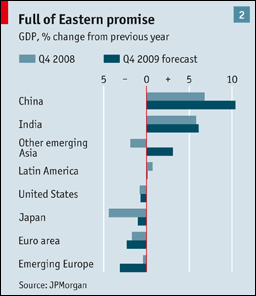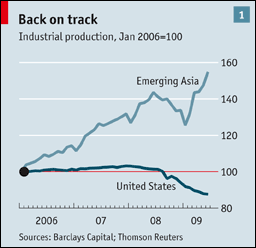Buoyed by domestic consumption, restoration of global trade and aggressive fiscal stimulus, GDP growth rates look set to return to their normal scorching pace by the last quarter, even as the developed economies are estimated to continue to contract...

Industrial production is taking off (jumping by an annualised rate of 36% in the second quarter in emerging Asia), while it is still on declining trend in the US and elsewhere in the West

Equity markets in the emerging economies have been booming since the beginning of the year on the back of positive feedback on the economic upturn. However, the scorching pace of growth (more than 50%) is bound to cause concerns about another asset bubble building up.

In a sign of the shift in the locus of global economic power, the gap between the growth rates in emerging Asia and the G7 is set to touch nine percentage points this year.

The article feels that the stimulus measures may have had greater impact in Asia as the households were not saddled with debt-ridden balance sheets and could therefore spend the tax cuts and cash handouts instead of saving them, while the large numbers of "shovel ready" infrastructure investment opportunities may have had the effect of boosting aggregate demand without the normal spending lags. Interestingly, even the loosening of monetary policy may have had greater impact in Asia in veiew of the fact that the local financial systems are not crippled (like in the West) leaving the banks keep open their lending taps. Therefore both fiscal and monetary stimulus may have had greater impact in lifting spending and boosting investments across Asia than the West.
And in keeping with this line of reasoning, India, which had the smallest monetary and fiscal stimulus, will not experience the same pace of rebound as the others in Asia who indulged in massive pump-priming. It had limited fiscal space, was less dependent on exports (and more domestic consumption driven), and the RBI, wary of seting off inflationary pressures, indulged in only limited monetary loosening, thereby depriving the economy of any boost from government spending.
While China suffers from an exceptionally low domestic consumption problem (a mere 35% of GDP), the others have consumption in the acceptable average of 58% of GDP. However, apart from China and India, investment has been declining and poses a problem for economic growth in the rest of emerging Asia.
The article points to an Asian monetary policy that remains firmly coupled to the developed economies. The inflating asset bubbles and a recovering economy means that the cheap money policy across emerging Asia will need to be reined in. However, any raising of rates poses two problems - on the one hand, it could nip in the bud the nascent recovery (by both increasing the cost of capital for businesses and reducing the wealth effect from an inflating asset bubble), while on the other hand, higher rates will (especially when rates are touching the zero-bound elsewhere) will attract even more foreign capital with all related problems (equity market boom and exchange rate appreciation). This will in turn force Central Banks to intervene in the forex markets (especially since exports are only now recovering) and undertake open market operations to purchase dollars and prevent their currencies from appreciating too much, thereby perpetuating the same macroeconomic imbalances (large reserves accumulation) that has contributed to the present economic crisis. This will lay the ground for inflationary pressures arising from the increase in money supply, unless the excess supply is sterilized.
This once again proves that despite the sub-prime meltdown led capital flight and recession induced export declines, all the ingredients for economic growth remain in tact in Asia - rapid productivity growth, relatively open markets, high saving rate to finance investment, and a young workforce. And all this growth has been happening without the one big growth engine - domestic consumption - remaining virtually on the shadows, especially in China.
Update 1
Nouriel Roubini argues that it may not be possible to say that the recession is over in the US with any degree of certainty and fears a double-dip recession. He cites four reasons for the "phantom recovery" - households need to deleverage and save more, which will constrain consumption for years; the financial system — both banks and non-bank institutions — is severely damaged and will keep their credit taps only half-open; the corporate sector faces a glut of capacity and are not likely to increase capital spending; and the releveraging of the public sector through large fiscal deficits and debt accumulation risks crowding out a recovery in private sector spending.
He argues that the effects of the policy stimulus, moreover, will fizzle out by early next year, requiring greater private demand to support continued growth. But domestic private demand, especially consumption, is now weak or falling in over-spending countries (the US, UK, Spain, Ireland, Australia and New Zealand, etc.), while not increasing fast enough in over-saving countries (China, other Asian countries, Germany and Japan, etc.) to compensate for the reduction in these countries’ net exports. Thus, there is a global slackening of aggregate demand relative to the glut of supply capacity, which will impede a robust global economic recovery.
And he foresees a double-dip recession for two reasons - the exit strategy from monetary and fiscal easing could be botched, because policymakers are damned if they do (raise taxes and reduce spending) and damned if they don’t (inflationary pressures could build up); oil, energy and food prices may be rising faster than economic fundamentals warrant, and could be driven higher by the wall of liquidity chasing assets, as well as by speculative demand.
Update 2
The Economix has the list of those predicting a W-shaped rcovery or a double dip recession here - or getting worse more slowly!
Update 3
And Roubini's assessment of the recovery prospects across the world is here.
No comments:
Post a Comment